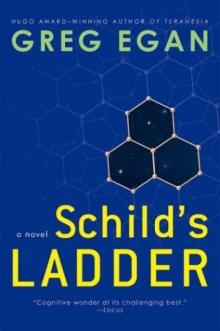Diaspora Read online
A Novel by
Greg Egan
HarperPrism
* * *
HarperPrism
A Division of HarperCollinsPublishers
10 East 53rd Street, New York, N.Y. 10022-5299
This is a work of fiction. The characters, incidents, and dialogues are products of the author's imagination and are not to be construed as real. Any resemblance to actual events or persons, living or dead, is entirely coincidental.
Copyright © 1998 by Greg Egan
All rights reserved. No part of this book may be used or reproduced in any manner whatsoever without written permission of the publisher, except in the case of brief quotations embodied in critical articles and reviews. For information address HarperCollinsPublishers, 10 East 53rd Street, New York, N.Y. 10022.
HarperCollins®, the HarperCollins logo, and HarperPrism® are trademarks of HarperCollinsPublishers Inc.
HarperPrism books may be purchased for educational, business, or sales promotional use. For information, please write: Special Markets Department, HarperCollinsPublishers, 10 East 53rd Street, New York, N.Y. 10022-5299.
Printed in the United States of America
First printing: February 1998
Designed by Lisa Pifher
ISBN 0-06-105281-7
Visit HarperPrism on the World Wide Web at http://www.harperprism.com
To learn more about Greg Egan, look for his website at http://www.netspace.net.au/~gregegan/
* * *
Table of Contents
Acknowledgments
Part One
1 – Orphanogenesis
2 – Truth Mining
3 – Bridgers
Part Two
4 – Lizard Heart
5 – Burster
6 – Divergence
Part Three
7 – Kozuch’s Legacy
8 – Short Cuts
9 – Degrees of Freedom
Part Four
10 – Diaspora
11 – Wang’s Carpets
Part Five
12 – Heavy
13 – Swift
14 – Embedded
Part Six
15 – 5 + 1
16 – Duality
Part Seven
17 – Partition of Unity
18 – Centers of Creation
Part Eight
19 – Pursuit
20 – Invariance
Glossary
References
eBook Notes
* * *
Acknowledgments
^ »
Part of this novel is adapted from the story “Wang’s Carpets,” which was first published in the anthology New Legends, edited by Greg Bear.
Thanks to Caroline Oakley, Anthony Cheetham, Peter Robinson, Annabelle Ager, Kate Messenger, David Pringle, Lee Montgomerie, Gardner Dozois, Sheila Williams, Greg Bear, Mike Arnautov, Dan Piponi, Philipp Keller, Sylvie Denis, Francis Valery, Henri Dhellemmes, Gerard Klein, and Bernard Sigaud.
* * *
Part One
« ^ »
Yatima surveyed the Doppler-shifted stars around the polis, following the frozen, concentric waves of color across the sky from expansion to convergence. Ve wondered what account they should give of themselves when they finally caught up with their quarry. They’d brought no end of questions to ask, but the flow of information couldn’t all be oneway. When the Transmuters demanded to know “Why have you followed us? Why have you come so far?”, where should ve begin?
Yatima had read pre-Introdus histories told on a single level, bounded by the fictions that individuals were as indivisible as quarks, and planetary civilizations nothing less than self-contained universes. Neither vis own history nor the Diaspora’s would fit between those imaginary lines. The real world was full of larger structures, smaller structures, simpler and more complex structures than the tiny portion comprising sentient creatures and their societies, and it required a profound myopia of scale and similarity to believe that everything beyond this shallow layer could be ignored. It wasn’t just a question of choosing to bury yourself in a closed world of synthetic scapes; the fleshers had never been immune to this myopia, nor had the most outward-looking citizens. No doubt at some time in their history the Transmuters had suffered from it too.
Of course, the Transmuters would already be aware of the very large, very dead celestial machinery that had driven the Diaspora to Swift and beyond. Their question would be, “Why have you come so much further? Why have you left your own people behind?”
Yatima couldn’t speak for vis fellow traveler, but the answer for ver lay at the opposite end of the scale, in the realm of the very simple, and the very small.
* * *
1
–
Orphanogenesis
« ^ »
Konishi polis, Earth
23 387 025 000 000 CST
15 May 2975, 11:03:17.154 UT
The conceptory was non-sentient software, as ancient as Konishi polis itself. Its main purpose was to enable the citizens of the polis to create offspring: a child of one parent, or two, or twenty — formed partly in their own image, partly according to their wishes, and partly by chance. Sporadically, though, every teratau or so, the conceptory created a citizen with no parents at all.
In Konishi, every home-born citizen was grown from a mind seed, a string of instruction codes like a digital genome. The first mind seeds had been translated from DNA nine centuries before, when the polis founders had invented the Shaper programming language to re-create the essential processes of neuroembryology in software. But any such translation was necessarily imperfect, glossing over the biochemical details in favor of broad, functional equivalence, and the full diversity of the flesher genome could not be brought through intact. Starting from a diminished trait pool, with the old DNA-based maps rendered obsolete, it was crucial for the conceptory to chart the consequences of new variations to the mind seed. To eschew all change would be to risk stagnation; to embrace it recklessly would be to endanger the sanity of every child.
The Konishi mind seed was divided into a billion fields: short segments, six bits long, each containing a simple instruction code. Sequences of a few dozen instructions comprised shapers: the basic subprograms employed during psychogenesis. The effects of untried mutations on fifteen million interacting shapers could rarely be predicted in advance; in most cases, the only reliable method would have been to perform every computation that the altered seed itself would have performed ... which was no different from going ahead and growing the seed, creating the mind, predicting nothing.
The conceptory’s accumulated knowledge of its craft took the form of a collection of annotated maps of the Konishi mind seed. The highest-level maps were elaborate, multidimensional structures, dwarfing the seed itself by orders of magnitude. But there was one simple map which the citizens of Konishi had used to gauge the conceptory’s progress over the centuries; it showed the billion fields as lines of latitude, and the sixty-four possible instruction codes as meridians. Any individual seed could be thought of as a path which zig-zagged down the map from top to bottom, singling out an instruction code for every field along the way.
Where it was known that only one code could lead to successful psychogenesis, every route on the map converged on a lone island or a narrow isthmus, ocher against ocean blue. These infrastructure fields built the basic mental architecture every citizen had in common, shaping both the mind’s overarching design and the fine details of vital subsystems.
Elsewhere, the map recorded a spread of possibilities: a broad landmass, or a scattered archipelago. Trait fields offered a selection of codes, each with a known effect on the mind’s detailed structure, with variations ranging from polar extremes of innate temperament
or aesthetics down to minute differences in neural architecture less significant than the creases on a flesher’s palm. They appeared in shades of green as wildly contrasting or as flatly indistinguishable as the traits themselves.
The remaining fields — where no changes to the seed had yet been tested, and no predictions could be made — were classified as indeterminate. Here, the one tried code, the known landmark, was shown as gray against white: a mountain peak protruding through a band of clouds which concealed everything to the east or west of it. No more detail could be resolved from afar; whatever lay beneath the clouds could only be discovered firsthand.
Whenever the conceptory created an orphan, it set all the benignly mutable trait fields to valid codes chosen at random, since there were no parents to mimic or please. Then it selected a thousand indeterminate fields, and treated them in much the same fashion: throwing a thousand quantum dice to choose a random path through terra incognita. Every orphan was an explorer, sent to map uncharted territory.
And every orphan was the uncharted territory itself.
* * *
The conceptory placed the new orphan seed in the middle of the womb’s memory, a single strand of information suspended in a vacuum of zeroes. The seed meant nothing to itself; alone, it might as well have been the last stream of Morse, fleeing through the void past a distant star. But the womb was a virtual machine designed to execute the seed’s instructions, and a dozen more layers of software led down to the polis itself, a lattice of flickering molecular switches. A sequence of bits, a string of passive data, could do nothing, change nothing — but in the womb, the seed’s meaning fell into perfect alignment with all the immutable rules of all the levels beneath it. Like a punched card fed into a Jacquard loom, it ceased to be an abstract message and became a part of the machine.
When the womb read the seed, the seed’s first shaper caused the space around it to be filled with a simple pattern of data: a single, frozen numerical wave train, sculpted across the emptiness like a billion perfect ranks of sand dunes. This distinguished each point from its immediate neighbors further up or down the same slope — but each crest was still identical to every other crest, each trough the same as every other trough. The womb’s memory was arranged as a space with three dimensions, and the numbers stored at each point implied a fourth. So these dunes were four-dimensional.
A second wave was added — running askew to the first, modulated with a slow steady rise — carving each ridge into a series of ascending mounds. Then a third, and a fourth, each successive wave enriching the pattern, complicating and fracturing its symmetries: defining directions, building up gradients, establishing a hierarchy of scales.
The fortieth wave plowed through an abstract topography bearing no trace of the crystalline regularity of its origins, with ridges and furrows as convoluted as the whorls of a fingerprint. Not every point had been rendered unique — but enough structure had been created to act as the framework for everything to come. So the seed gave instructions for a hundred copies of itself to be scattered across the freshly calibrated landscape.
In the second iteration, the womb read all of the replicated seeds — and at first, the instructions they issued were the same, everywhere. Then, one instruction called for the point where each seed was being read to jump forward along the bit string to the next field adjacent to a certain pattern in the surrounding data: a sequence of ridges with a certain shape, distinctive but not unique. Since each seed was embedded in different terrain, each local version of this landmark was situated differently, and the womb began reading instructions from a different part of every seed. The seeds themselves were all still identical, but each one could now unleash a different set of shapers on the space around it, preparing the foundations for a different specialized region of the psychoblast, the embryonic mind.
The technique was an ancient one: a budding flower’s nondescript stem cells followed a self-laid pattern of chemical cues to differentiate into sepals or petals, stamens or carpels; an insect pupa doused itself with a protein gradient which triggered, at different doses, the different cascades of gene activity needed to sculpt abdomen, thorax, or head. Konishi’s digital version skimmed off the essence of the process: divide up space by marking it distinctively, then let the local markings inflect the unwinding of all further instructions, switching specialized subprograms on and off — subprograms which in turn would repeat the whole cycle on ever finer scales, gradually transforming the first rough-hewn structures into miracles of filigreed precision.
By the eighth iteration, the womb’s memory contained a hundred trillion copies of the mind seed; no more would be required. Most continued to carve new detail into the landscape around them — but some gave up on shapers altogether, and started running shriekers: brief loops of instructions which fed streams of pulses into the primitive networks which had grown up between the seeds. The tracks of these networks were just the highest ridges the shapers had built, and the pulses were tiny arrowheads, one and two steps higher. The shapers had worked in four dimensions, so the networks themselves were three-dimensional. The womb breathed life into these conventions, making the pulses race along the tracks like a quadrillion cars shuttling between the trillion junctions of a ten-thousand-tiered monorail.
Some shriekers sent out metronomic bit-streams; others produced pseudorandom stutters. The pulses flowed through the mazes of construction where the networks were still being formed — where almost every track was still connected to every other, because no decision to prune had yet been made. Woken by the traffic, new shapers started up and began to disassemble the excess junctions, preserving only those where a sufficient number of pulses was arriving simultaneously — choosing, out of all the countless alternatives, pathways which could operate in synchrony. There were dead ends in the networks-in-progress, too — but if they were traveled often enough, other shapers noticed, and constructed extensions. It didn’t matter that these first streams of data were meaningless; any kind of signal was enough to help whittle the lowest-level machinery of thought into existence.
In many polises, new citizens weren’t grown at all; they were assembled directly from generic subsystems. But the Konishi method provided a certain quasi-biological robustness, a certain seamlessness. Systems grown together, interacting even as they were being formed, resolved most kinds of potential mismatch themselves, with no need for an external mind-builder to fine-tune all the finished components to ensure that they didn’t clash.
Amidst all this organic plasticity and compromise, though, the infrastructure fields could still stake out territory for a few standardized subsystems, identical from citizen to citizen. Two of these were channels for incoming data — one for gestalt, and one for linear, the two primary modalities of all Konishi citizens, distant descendants of vision and hearing. By the orphan’s two-hundredth iteration, the channels themselves were fully formed, but the inner structures to which they fed their data, the networks for classifying and making sense of it, were still undeveloped, still unrehearsed.
Konishi polis itself was buried two hundred meters beneath the Siberian tundra, but via fiber and satellite links the input channels could bring in data from any forum in the Coalition of Polises, from probes orbiting every planet and moon in the solar system, from drones wandering the forests and oceans of Earth, from ten million kinds of scape or abstract sensorium. The first problem of perception was learning how to choose from this superabundance.
In the orphan psychoblast, the half-formed navigator wired to the controls of the input channels began issuing a stream of requests for information. The first few thousand requests yielded nothing but a monotonous stream of error codes; they were incorrectly formed, or referred to non-existent sources of data. But every psychoblast was innately biased toward finding the polis library (if not, it would have taken millennia) and the navigator kept trying until it hit on a valid address, and data flooded through the channels: a gestalt image of a lion, accompanied by the linear w
ord for the animal.
The navigator instantly abandoned trial and error and went into a spasm of repetition, summoning the same frozen image ot the lion again and again. This continued until even the crudest of its embryonic change-discriminators finally stopped firing, and it drifted back toward experimentation.
Gradually, a half-sensible compromise evolved between the orphan’s two kinds of proto-curiosity: the drive to seek out novelty, and the drive to seek out recurring patterns. It browsed the library, learning how to bring in streams of connected information — sequential images of recorded motion, and then more abstract chains of cross-references — understanding nothing, but wired to reinforce its own behavior when it struck the right balance between coherence and change.
Images and sounds, symbols and equations, flooded through the orphan’s classifying networks, leaving behind, not the fine details — not the spacesuited figure standing on gray-and-white rock against a pitch black sky; not the calm, naked figure disintegrating beneath a gray swarm of nanomachines — but an imprint of the simplest regularities, the most common associations. The networks discovered the circle/sphere: in images of the sun and planets, in iris and pupil, in fallen fruit, in a thousand different artworks, artifacts, and mathematical diagrams. They discovered the linear word for “person,” and bound it tentatively both to the regularities which defined the gestalt icon for “citizen,” and to the features they found in common among the many images of fleshers and gleisner robots.
By the five-hundredth iteration, the categories extracted from the library’s data had given rise to a horde of tiny sub-systems in the input-classifying networks: ten thousand word-traps and image-traps, all poised and waiting to be sptung; ten thousand pattern-recognizing monomaniacs staring into the information stream, constantly alert for their own special targets.

 Zendegi
Zendegi Permutation City
Permutation City The Eternal Flame
The Eternal Flame Artifacts
Artifacts Wang's Carpets
Wang's Carpets Dichronauts
Dichronauts Incandescence
Incandescence Teranesia
Teranesia Schild's Ladder
Schild's Ladder Quarantine
Quarantine The Four Thousand, the Eight Hundred
The Four Thousand, the Eight Hundred The Clockwork Rocket
The Clockwork Rocket Zeitgeber
Zeitgeber Phoresis
Phoresis The Nearest
The Nearest Diaspora
Diaspora Instantiation
Instantiation Distress
Distress An Unusual Angle
An Unusual Angle Oceanic
Oceanic The Arrows of Time
The Arrows of Time Axiomatic
Axiomatic![Anthology 2. Luminous [1998, 2010] Read online](http://i1.bookreadfree.com/i/03/18/anthology_2_luminous_1998_2010_preview.jpg) Anthology 2. Luminous [1998, 2010]
Anthology 2. Luminous [1998, 2010] Perihelion Summer
Perihelion Summer Luminous
Luminous